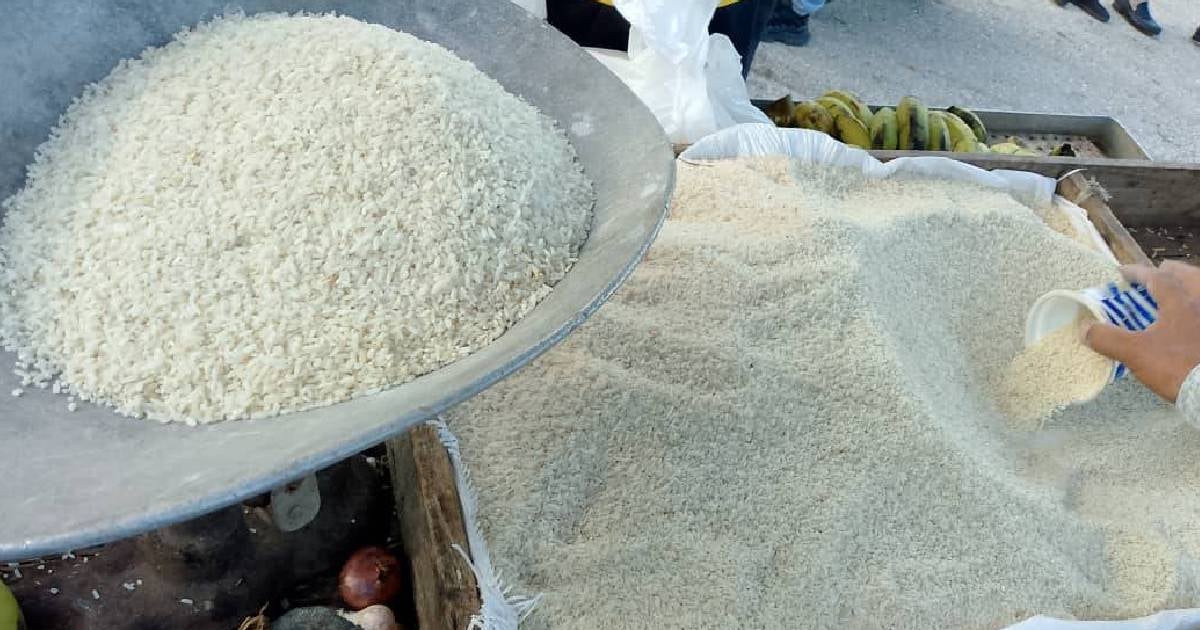Cuba is grappling with a worsening food crisis as prices of basic necessities in the black market continue to soar. Recently, the cost of a pound of rice has surged to an astounding 300 Cuban pesos (CUP), underscoring the severe shortages and declining purchasing power faced by the population.
Cubans across several provinces report that obtaining rice through the government-issued ration book has become nearly impossible, forcing families to turn to the informal market where prices have reached exorbitant levels. In Santa Clara, residents have publicly complained that nearby small businesses display rice prices at 300 CUP per pound on chalkboards, despite government efforts to cap the price at 170 CUP.
"Can't you be less corrupt and do something for the people?" a local resident voiced on social media, accusing local authorities of colluding with vendors. "We used to find it for 200 or 250 pesos, but now it's a luxury. If you don't have money, you don't eat," commented a Havana resident who wished to remain anonymous. In several areas of the capital, imported rice from Brazil, Uruguay, and India has exceeded 350 CUP per pound, fueling further uncertainty among the populace.
Widespread Impact of Rice Shortages
In municipalities like Quivicán, in Mayabeque province, the price stands at 300 CUP and is not exclusive to the black market. The scarcity of rice in state markets is partly due to reduced imports and distribution challenges within the country. Cuba relies heavily on foreign purchases to ensure the supply of this staple, but the economic crisis and currency shortages have complicated the arrival of essential foods.
In online buying and selling groups, prices reflect this crisis. Imported Rainha rice is being sold at 590 CUP per kilo in 30-unit bundles, while San Diego rice is priced at 620 CUP per kilo with a minimum purchase of 30 bundles. Other sellers offer Guyanese rice at 280 CUP per pound, indicating that high prices aren't limited to a single supplier.
Government Efforts and Public Skepticism
Experts attribute the shortages and inflation to a combination of factors, including the decline in domestic production, the government's financial struggles, and state-imposed trade restrictions. Recently, the Ministry of Domestic Trade (Mincin) announced the arrival of a rice shipment at Havana's port, intended to partially address the delays in distributing the regulated family basket over recent months. However, this shipment will only partially meet the accumulated needs, with distribution extending into February and March.
In an attempt to control inflation, the government has set price ceilings for rice. In Camagüey, the price was fixed at 155 CUP per pound, leading to the mass closure of vendors in the Hatibonico market, as sellers find this rate unsustainable given current costs.
Meanwhile, in Santiago de Cuba, Communist Party Secretary Beatriz Johnson Urrutia announced a distribution of 14 pounds of rice as part of the basic food basket, provoking mixed reactions from the population, who doubt the continuity and stability of these deliveries. The situation contrasts with the reality in some luxury hotels. A Cuban staying at the Iberostar Laguna Azul in Varadero shared on social media that during her stay, the buffet lacked rice, offering spaghetti as a substitute.
This incident sparked debates about the quality and availability of food in tourist facilities amidst the national food crisis. Many Cubans rely on remittances sent by family members abroad to afford the steep black market prices. However, those without this financial support face an extremely precarious situation.
Thus far, the Cuban government has not offered concrete solutions to curb the price surge or ensure a stable supply of rice through official channels, leaving the population mired in an unprecedented food crisis.
Key Questions on Cuba's Food Crisis and Rice Shortages
Why are rice prices rising so dramatically in Cuba?
The dramatic rise in rice prices in Cuba is due to a combination of reduced imports, distribution issues, a decline in domestic production, and the broader economic crisis affecting the country.
How are Cuban citizens coping with the escalating food prices?
Many Cubans are resorting to the informal market to buy essentials at much higher prices. Those with relatives abroad often depend on remittances to afford these costs, while others face severe hardship.
What measures has the Cuban government taken to address the food crisis?
The Cuban government has introduced price ceilings for rice and announced shipments to alleviate delayed deliveries, but these efforts have been insufficient to stabilize the market or meet the population's needs.
